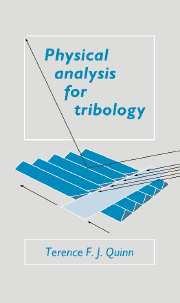Book contents
- Frontmatter
- Contents
- Preface
- Nomenclature list
- 1 Tribology
- 2 Macroscopic physical techniques
- 3 Microscopic physical techniques for studying atomic arrangement
- 4 Microscopic techniques for studying atomic structure
- 5 The analysis of lubricant films
- 6 The analysis of surface temperatures in tribo-systems
- 7 The analysis of pitting failures in tribo-systems
- 8 The analysis of oxidational wear in tribo-systems
- 9 The application of physical techniques to selected ceramic tribo-systems
- References
- Index
4 - Microscopic techniques for studying atomic structure
Published online by Cambridge University Press: 29 October 2009
- Frontmatter
- Contents
- Preface
- Nomenclature list
- 1 Tribology
- 2 Macroscopic physical techniques
- 3 Microscopic physical techniques for studying atomic arrangement
- 4 Microscopic techniques for studying atomic structure
- 5 The analysis of lubricant films
- 6 The analysis of surface temperatures in tribo-systems
- 7 The analysis of pitting failures in tribo-systems
- 8 The analysis of oxidational wear in tribo-systems
- 9 The application of physical techniques to selected ceramic tribo-systems
- References
- Index
Summary
Optical spectra
Description of the technique
In the simplest form of optical emission spectrometer, an electrical discharge is produced between two electrodes, at least one of which consists of, or contains, the sample to be analysed. A high voltage accelerates electrons from the cathode (the negative electrode) onto the anode, where they produce heat and the release of positive ions. Hence, some portion of the sample is vaporized by the discharge, the vaporized species become dissociated, and the resultant atoms (or ions) are excited either thermally or through collisions with each other. An excited atom or ion emits light, which is dispersed into its component wavelengths (λ) by means of a diffraction grating. In Section 2.1.4 we saw that if we place two slits in front of the sample slit source, then maxima appeared at distances from the undeviated beam that were multiples of (λDss/cz), where the reader may recall that Dss was the distance from the slits to the screen and cz was the distance between the slits (see Figure 2.7). We can write this in terms of diffraction angle Ø, since in ΔGOM of that figure, we see tan Ø = (λ/cz) for the first maximum. If the light source behind the single slit is not monochromatic but contains several wavelengths, then we would obtain several overlapping fringe patterns from each of the wavelengths present.
- Type
- Chapter
- Information
- Physical Analysis for Tribology , pp. 148 - 201Publisher: Cambridge University PressPrint publication year: 1991



